Part of the experience of staying in a ryokan, a traditional Japanese guesthouse, is the relief you’ll feel as soon as you walk in the door. It’s a mindset shift, the opportunity to fully switch to a different, older pace of life where there’s little to do but relax and enjoy the serene surroundings.
Ryokan design is typically spare, reflecting the traditional aesthetic of Japan, and there are rarely televisions or other trappings of the modern age when you travel here (WiFi is typically available, though, if you must).
Hardwood floors are lined with tatami (rice straw) mats. Rooms are modular; staff transform the sitting room into the bedroom after you eat dinner, pulling out single futon mattresses (true even if you’re traveling with a spouse or partner), buckwheat pillows, and bedding according to the season — heavy layers of thick blankets in winter and lighter linens in warmer weather.
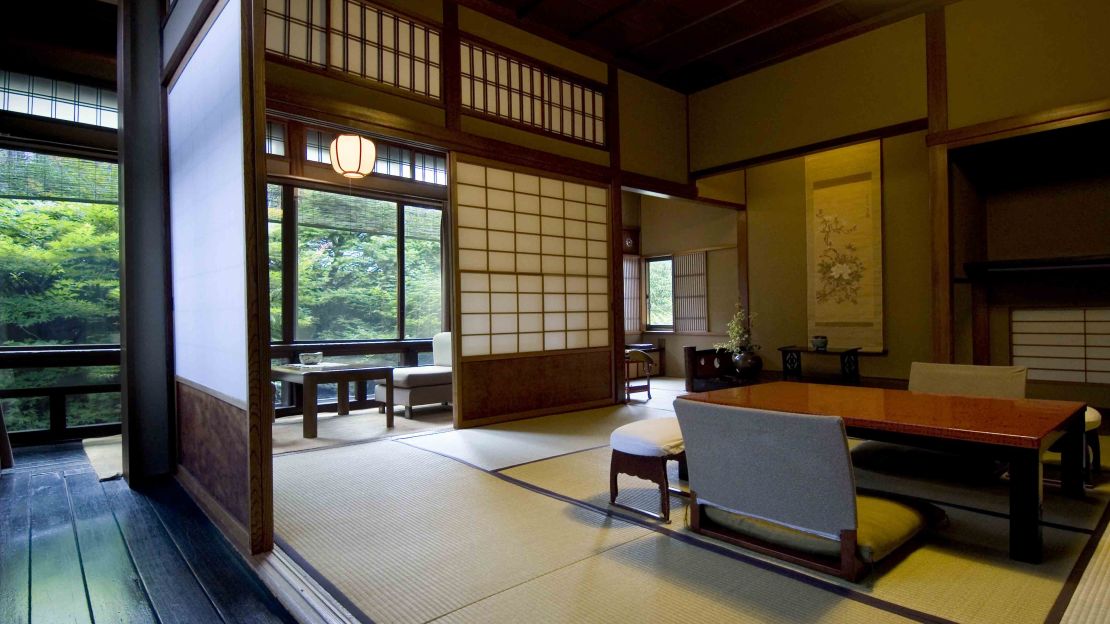
Guests even shed their normal clothes during ryokan stays. Slipping into yukata (lightweight cotton kimono) provided by the guesthouse, you’ll stay in the robe, socks and wooden shoes for meals, at the bath and even as you wander around town.
About that bath: Village ryokan are often rustic, centuries-old wood and paper buildings, set around mineral-rich hot springs that bubble out of Japan’s mountainous volcanic backbone. These springs, known as onsen, have been celebrated for millennia for their health properties. These can be physical – some waters are especially good for arthritis, others for the skin – but a soak in any hot spring imparts a sense of tranquility to those lucky enough to partake.
Combined with the quiet rhythm of the ryokan, the rustle of kimono and padding of socks on tatami, you may not remember what stress even feels like.
Here are six of Japan’s most exquisite ryokans.
Lamp no Yado
In a rocky cove on the very tip of the Noto Peninsula on Japan’s main island of Honshu, this windswept ryokan has hosted travelers seeking solace and isolation for more than four centuries.
The ryokan was originally built around the Yoshigaura onsen, a freshwater hot spring bubbling up from the sea of Japan. These days, you can soak in the indoor or outdoor baths, or in your own cedar-lined rotemburo, or private outdoor tub, as part of a suite package.
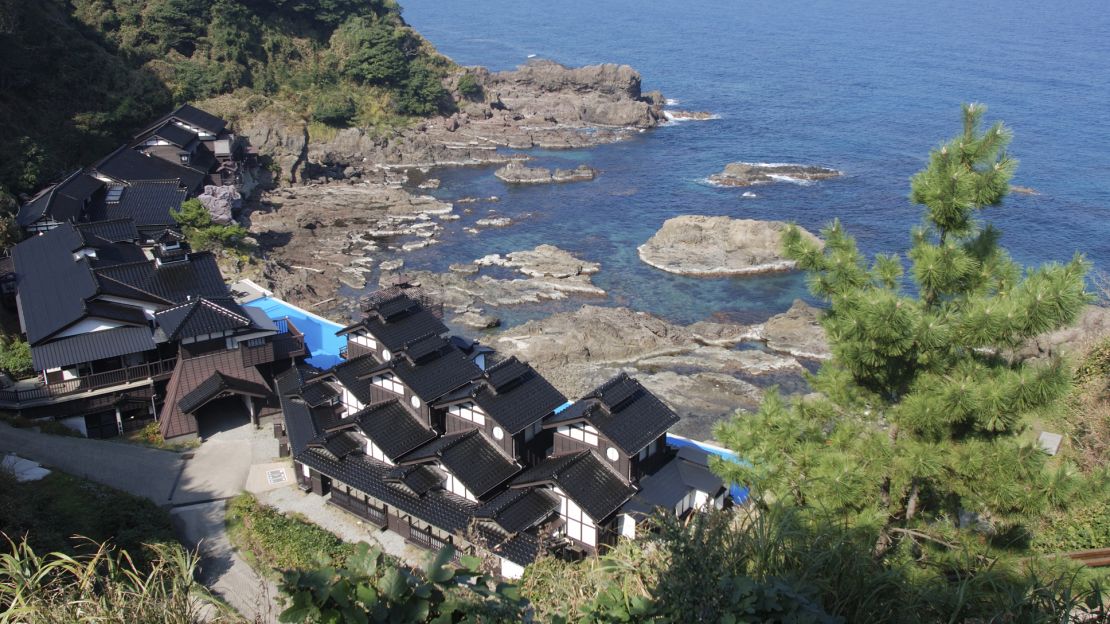
The property features a spa with gold-leaf treatments, as well as a wide blue swimming pool which – wedged into a diminutive hot spring of black rock – almost feels out of place in the rugged surroundings.
Lamp no Yado is located on Toyama Bay, known throughout Japan for its unique marine ecology. If you visit in the spring, your gorgeous, multi-course dinner may include shiro ebi (white shrimp) and hotaru ika (firefly squid), for which the region is famous.
Whether you’re soaking in an onsen, sipping Lamp no Yado’s house-brewed sake or feasting on seafood, or watching the waves lap the volcanic rocks, as weary pilgrims have done for centuries, it’s quietly mesmerizing.
Lamp no Yado, 10-11 Jike Misaki-Machi Suzu Ishikawa, Japan; +81 (0768) 86-8000
Beniya Mukayu
Set in a mossy garden of Japanese maple and persimmon trees, Beniya Mukayu is the most serene place to stay in Kaga, an area in the mountains between Kyoto and Kanazawa famous for its delightful onsen ryokan – an inn set near or on natural hot springs and often open to the public for a fee.
The name Mukayu is based on the concept of “nothingness,” named by the Chinese philosopher Zhuang Zhou. The idea of emptiness takes on a comforting aspect here, since the few things that are present are just so beautiful.
Set near the Yamashiro hot spring, which became popular in the 10th century for its natural healing qualities, Mukayu invites guests to soak in the onsen and not do much else.
The owner’s personal friendship with Kenya Hara, the Japanese graphic designer and art director of Muji, means that this is one of the most visually stunning properties in all of Japan.
Hara has contributed some of his personal art collection to appear in the ryokan (the fascinating Tsukubai, a modern reimagining of a traditional washbasin at the entrance to Buddhist holy places, is on the first floor).
Guests are welcome to enjoy the art or borrow design books from the ryokan’s library and unwind in the study, but remember: Part of the true ryokan experience, according to the architect, is enjoying the feeling of having nothing to do.
Beniya Mukayu, 55 1 3 Kaga-shi Ishikawa, Japan; +81 (0761) 77 1340
Nishimuraya Honkan
Nestled into the side of a densely forested hillside, west of Kyoto near the Sea of Japan’s coast, this seventh-generation onsen ryokan is a labyrinth of wooden and paper rooms surrounding private gardens filled with Japanese pines, carp-filled rock pools, and seasonal flowering plants.
Nishimuraya is the crown jewel of Kinosaki Onsen, a town that has drawn bathers to its healing waters since the eighth century. The buildings here are clustered prettily around a tree-lined canal that bursts into flower in the spring.
The Nishimuraya public baths are gorgeous, lined in golden wood and dating from 1854.
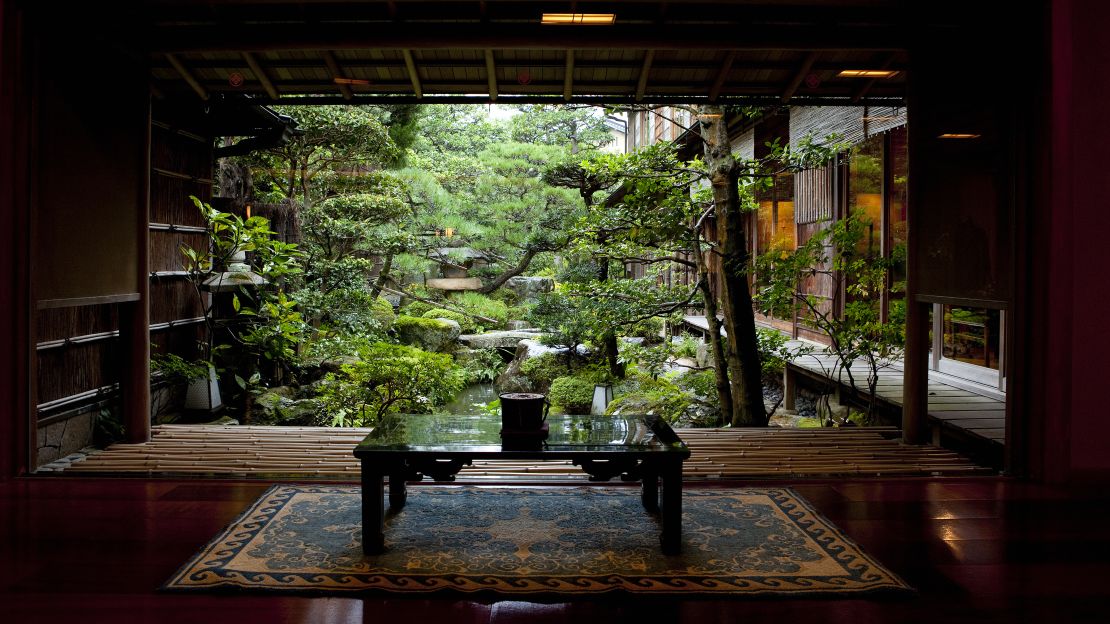
Part of the fun of visiting Kinosaki though is joining the other onsen pilgrims in languidly shuffling from one public bathhouse to the next. Kinosaki has seven historic public onsen, one for each day of the week, locals say. Nishimuraya guests receive a yumepa pass which entitles them to visit each public bath in Kinosaki for free.
As you wander around town, you’ll notice that everyone is wearing a yukata, geta (traditional wooden thong sandals), and a sleepy, happy expression, as if marveling at their good fortune.
Nishimuraya Honkan, Toyooka 4 6 9 Hyogo 669-6101, Japan; +81 796-32-2211
Kayotei
The grounds of Kayotei stretch up a mountain, and down to a rushing river at the bottom of the Yamanaka Onsen gorge. All the ryokan’s windows face the mountain, meaning you won’t see another building during your entire stay if you choose not to.
Kayotei’s ten rooms are immaculately decorated with antique furniture collected by the owner’s family for generations. The decor changes seasonally to reflect the weather. Plants in the central atrium garden are selected for their seasonality, and, often, special new pieces the collectors wish to highlight are featured. These include painted screens, antique festival masks and the fine pottery the region is known for.
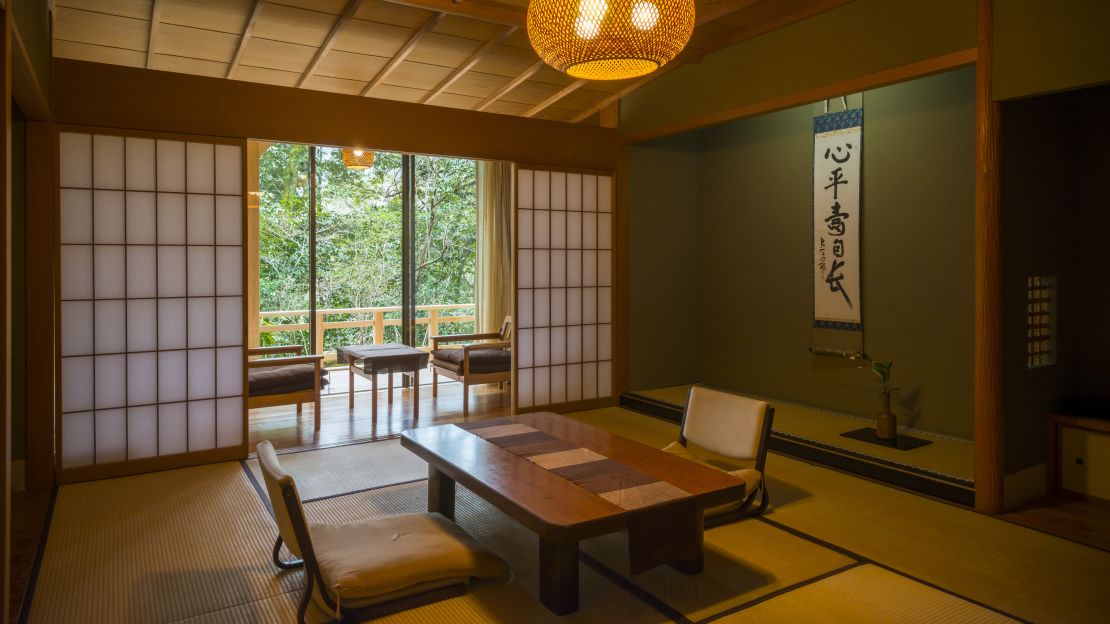
Seasonal multi-course kaiseki (Japanese haute cuisine) is a highlight at Kayotei. The kitchen staff ventures onto the mountain every day to forage fresh and hyper-local herbs, vegetables and roots. Dishes arrive as meticulously arranged as a work of art, so you’ll probably want to take a few pictures for the ‘Gram.
You may appreciate the cuisine even more knowing that the chefs sometimes compete with wild boar for the best herbs and roots. The animals roam the property freely and can sometimes be seen drinking from the natural pool below the dining room’s terrace, where guests enjoy breakfast in a communal setting. For dinner, you may take dinner in your room, or in the private dining rooms on the property.
Kayotei and Yamanaka Onsen, 1 2 0 Higashimachi Kaga Ishikawa 922-0114, Japan; +81 761-78-1410
Otozure
Japan’s best hotels are usually either hyper-traditional, with only wood, paper and lacquer, or ultramodern, with no color at all besides white, black and shades of gray.
The decor at Otozure, in the stunning mountains of Honshu’s Yamaguchi prefecture, is reflective of neither aesthetic; rather, it combines interesting elements of both traditional and modern ryokan design, in warm, orange hues that are unexpectedly relaxing.
Large lanterns light a covered pathway to the traditional Japanese tea house, where guests partake in a traditional matcha tea ceremony upon arrival.
In densely populated Japan, it’s a rare treat to see a hillside that’s not topped with a house, hotel or observation deck. From Otozure’s courtyard water garden, two perfect green cones emerge from behind the building, imparting a sense of remoteness hard to find in the rest of the country. You’ll feel immediately at ease with the first sip of welcoming, warm tea.
Otozure, Fukawayumoto 2208 Nagato Yamaguchi 759-4103, Japan; +81 837-25-3377
Hiiragiya
It’s no secret that Kyoto is one of the world’s most exquisitely beautiful cities. Spared at the last moment from nuclear annihilation during World War II (the “Fat Man” weapon was dropped on the city of Nagasaki instead), Kyoto remains one of Japan’s finest examples of traditional architecture. There are almost too many sublime ryokan in Kyoto to choose from.
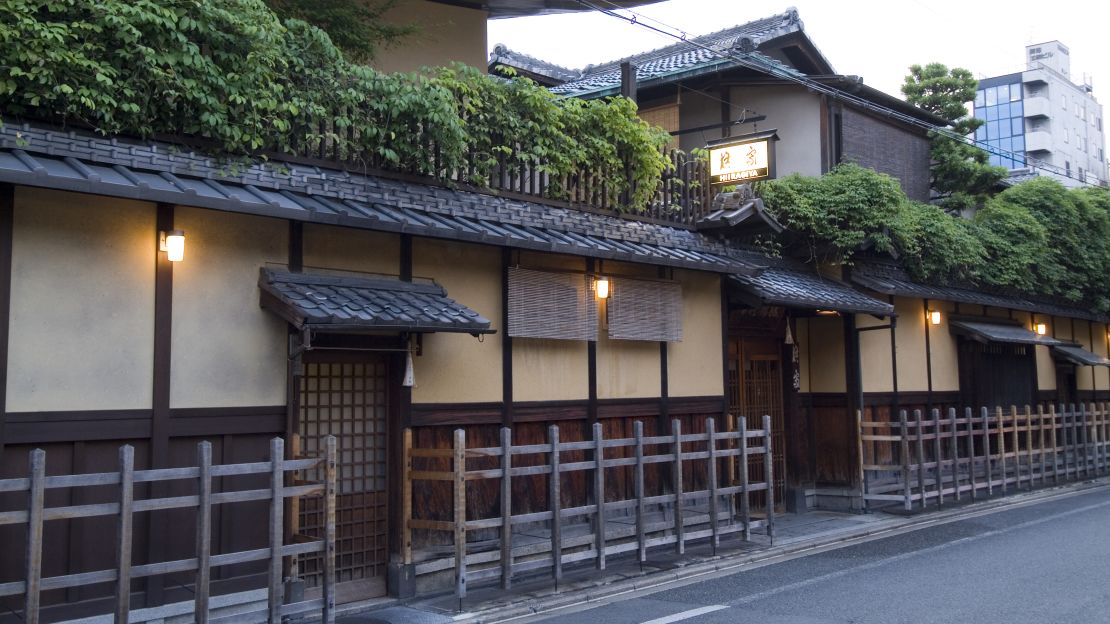
The experience of hospitality at Hiiragiya puts it ahead of the pack. The staff seem to be mind readers: They’re there the instant before you even realize you have a question, but absent if you want to pad silently along the stone pathway of the early 19th-century garden.
Hiiragiya is named after a type of holly thought to bring good luck, and the motif appears throughout the property. The owners and staff proudly point out tiny artistic embellishments in each of the 28 rooms, obviously proud of the historical legacy of their work.
The ryokan is known as a favorite among Japanese literary luminaries, many of whom have written eloquently of the space. You may be inspired to do the same after a stay here.
Hiiragiya, Nakahakusancho Fuyacho Anekoji-agaru Nakagyo-ku, Kyoto 604-8094, Japan; +81 75-221-1136
Stephanie d’Arc Taylor is a travel and culture writer whose work has appeared in CNN Travel, The New York Times, The Guardian, Kinfolk Magazine and other publications. She co-authored the latest “Lonely Planet Japan” guidebook, to be released in 2019. Finally, she’s the co-founder of Jaleesa, a venture-capital funded social impact business based in Beirut.



